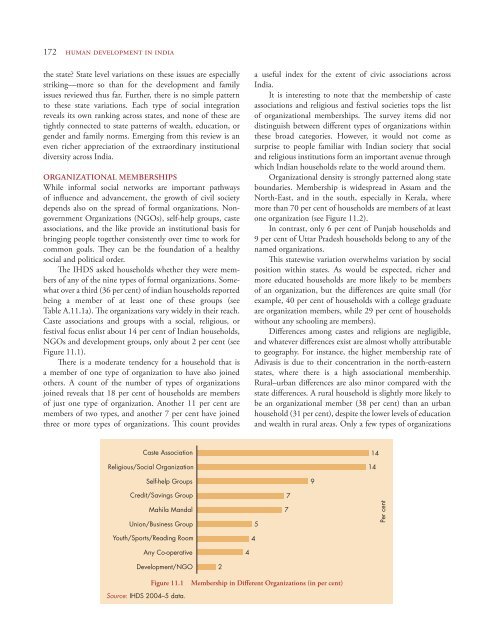Human Development in India - NCAER
Human Development in India - NCAER
Human Development in India - NCAER
You also want an ePaper? Increase the reach of your titles
YUMPU automatically turns print PDFs into web optimized ePapers that Google loves.
172 human development <strong>in</strong> <strong>in</strong>diathe state? State level variations on these issues are especiallystrik<strong>in</strong>g—more so than for the development and familyissues reviewed thus far. Further, there is no simple patternto these state variations. Each type of social <strong>in</strong>tegrationreveals its own rank<strong>in</strong>g across states, and none of these aretightly connected to state patterns of wealth, education, orgender and family norms. Emerg<strong>in</strong>g from this review is aneven richer appreciation of the extraord<strong>in</strong>ary <strong>in</strong>stitutionaldiversity across <strong>India</strong>.ORGANIZATIONAL MEMBERSHIPSWhile <strong>in</strong>formal social networks are important pathwaysof <strong>in</strong>fluence and advancement, the growth of civil societydepends also on the spread of formal organizations. NongovernmentOrganizations (NGOs), self-help groups, casteassociations, and the like provide an <strong>in</strong>stitutional basis forbr<strong>in</strong>g<strong>in</strong>g people together consistently over time to work forcommon goals. They can be the foundation of a healthysocial and political order.The IHDS asked households whether they were membersof any of the n<strong>in</strong>e types of formal organizations. Somewhatover a third (36 per cent) of <strong>in</strong>dian households reportedbe<strong>in</strong>g a member of at least one of these groups (seeTable A.11.1a). The organizations vary widely <strong>in</strong> their reach.Caste associations and groups with a social, religious, orfestival focus enlist about 14 per cent of <strong>India</strong>n households,NGOs and development groups, only about 2 per cent (seeFigure 11.1).There is a moderate tendency for a household that isa member of one type of organization to have also jo<strong>in</strong>edothers. A count of the number of types of organizationsjo<strong>in</strong>ed reveals that 18 per cent of households are membersof just one type of organization. Another 11 per cent aremembers of two types, and another 7 per cent have jo<strong>in</strong>edthree or more types of organizations. This count providesa useful <strong>in</strong>dex for the extent of civic associations across<strong>India</strong>.It is <strong>in</strong>terest<strong>in</strong>g to note that the membership of casteassociations and religious and festival societies tops the listof organizational memberships. The survey items did notdist<strong>in</strong>guish between different types of organizations with<strong>in</strong>these broad categories. However, it would not come assurprise to people familiar with <strong>India</strong>n society that socialand religious <strong>in</strong>stitutions form an important avenue throughwhich <strong>India</strong>n households relate to the world around them.Organizational density is strongly patterned along stateboundaries. Membership is widespread <strong>in</strong> Assam and theNorth-East, and <strong>in</strong> the south, especially <strong>in</strong> Kerala, wheremore than 70 per cent of households are members of at leastone organization (see Figure 11.2).In contrast, only 6 per cent of Punjab households and9 per cent of Uttar Pradesh households belong to any of thenamed organizations.This statewise variation overwhelms variation by socialposition with<strong>in</strong> states. As would be expected, richer andmore educated households are more likely to be membersof an organization, but the differences are quite small (forexample, 40 per cent of households with a college graduateare organization members, while 29 per cent of householdswithout any school<strong>in</strong>g are members).Differences among castes and religions are negligible,and whatever differences exist are almost wholly attributableto geography. For <strong>in</strong>stance, the higher membership rate ofAdivasis is due to their concentration <strong>in</strong> the north-easternstates, where there is a high associational membership.Rural–urban differences are also m<strong>in</strong>or compared with thestate differences. A rural household is slightly more likely tobe an organizational member (38 per cent) than an urbanhousehold (31 per cent), despite the lower levels of educationand wealth <strong>in</strong> rural areas. Only a few types of organizationsFigure 11.1Source: IHDS 2004–5 data.Membership <strong>in</strong> Different Organizations (<strong>in</strong> per cent)















